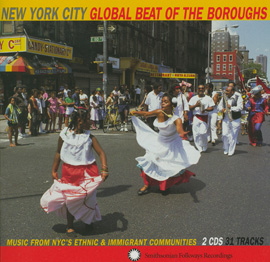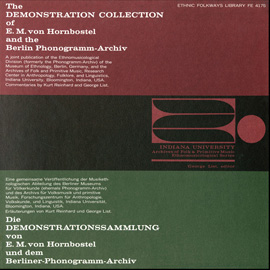-
Folkways Fast Five: Joan Hua
Fast Five is a five-question speed interview with members of the Smithsonian Folkways Recordings staff.
Hello, and welcome to Fast Five, where we at Smithsonian Folkways Recordings talk to a member of the staff about their favorite parts of the collection. I’m here today with Joan Hua. Could you introduce yourself?
I’m Joan Hua, I’m currently the guest editor and web producer for Smithsonian Folkways magazine.
What was your first Folkways album?
 I think it must have been Jean Ritchie [Jean Ritchie: Ballads from her Appalachian Family Tradition] or Lucinda Williams [Happy Woman Blues], I used to be really into Appalachian folk and Irish Celtic music.
I think it must have been Jean Ritchie [Jean Ritchie: Ballads from her Appalachian Family Tradition] or Lucinda Williams [Happy Woman Blues], I used to be really into Appalachian folk and Irish Celtic music.
What are some of your current favorite albums? What do you like about them?
 Currently, I think I’m very excited about some albums that have a lot of creative collaboration. One is Rainbowin the Central Asian series. I like the Central Asian series a lot in general, but particularly Rainbow because it’s a collaboration with the Kronos Quartet and a lot of musicians with different backgrounds like Azerbaijan and other parts of Central Asia. They’re all very strong musicians, but also trying to do something creative and exploring deep into the roots of different kinds of music.
Currently, I think I’m very excited about some albums that have a lot of creative collaboration. One is Rainbowin the Central Asian series. I like the Central Asian series a lot in general, but particularly Rainbow because it’s a collaboration with the Kronos Quartet and a lot of musicians with different backgrounds like Azerbaijan and other parts of Central Asia. They’re all very strong musicians, but also trying to do something creative and exploring deep into the roots of different kinds of music.
I also really like Quetzal’s Imaginaries, partly because it came out when I first started here. I like the music a lot, and I also like what it represents— it’s a Chicano group from East L.A., and they are a Latin rock band, but they also do a lot of stuff with political and social engagement, and also have a feminist voice. There are a lot of really great stories surrounding that album and what the group does.
I also really like Pete Seeger’s [The Complete Bowdoin College Concert, 1960], and Luiz Bonfa [Solo in Rio 1959], those are some other favorites.
What do you think is a hidden gem in the collection?
 I can’t really say which ones are hidden, I don’t know which people know about. This is partly because I am currently editing the Folkways Magazine and the next issue is going to be on immigration, but I’ve always liked the Safarini album [Safarini in transit: Music of African immigrants], I think it’s kind of hidden. It’s this album with five different ensembles of African musicians, African immigrants in Seattle and Portland, on the west coast and the Pacific Northwest. That album has a theme on immigration and journey. That’s one I really like. I always hear that not many people know about it.
I can’t really say which ones are hidden, I don’t know which people know about. This is partly because I am currently editing the Folkways Magazine and the next issue is going to be on immigration, but I’ve always liked the Safarini album [Safarini in transit: Music of African immigrants], I think it’s kind of hidden. It’s this album with five different ensembles of African musicians, African immigrants in Seattle and Portland, on the west coast and the Pacific Northwest. That album has a theme on immigration and journey. That’s one I really like. I always hear that not many people know about it.
 Another one is part of the Global Beats series, it’s [New York City: Global Beat of the Boroughs]. It’s exploring immigrant communities, or ethnic communities, in New York City, so it has a lot of different kinds of music in one album. I like how it’s focusing on a city, and going across different musical categories and ethnic groups and traditions.
Another one is part of the Global Beats series, it’s [New York City: Global Beat of the Boroughs]. It’s exploring immigrant communities, or ethnic communities, in New York City, so it has a lot of different kinds of music in one album. I like how it’s focusing on a city, and going across different musical categories and ethnic groups and traditions.
What’s your favorite album art?
 One that comes to mind is The Sounding Joythat Sonia Cohen Cramer designed. I like her work a lot, she’s a major designer that Smithsonian Folkways works with. For Sounding Joy, it’s a children’s and family music album by Elizabeth Mitchell, kind of about solstice and Christmas, winter holidays, there’s this original artwork, photographs and it’s kind of 3-D and beautifully laid out. The booklet’s really pretty, not just the cover.
One that comes to mind is The Sounding Joythat Sonia Cohen Cramer designed. I like her work a lot, she’s a major designer that Smithsonian Folkways works with. For Sounding Joy, it’s a children’s and family music album by Elizabeth Mitchell, kind of about solstice and Christmas, winter holidays, there’s this original artwork, photographs and it’s kind of 3-D and beautifully laid out. The booklet’s really pretty, not just the cover.
 For Folkways records, I really like a lot of the art by Ronald Clyne, he’s definitely a major designer. One cover I have in mind is Demonstration Collection [The Demonstration Collection of E.M. von Hornbostel and the Berlin Phonogramm-Archiv], I can’t say the full name, but I always have the cover in mind.
For Folkways records, I really like a lot of the art by Ronald Clyne, he’s definitely a major designer. One cover I have in mind is Demonstration Collection [The Demonstration Collection of E.M. von Hornbostel and the Berlin Phonogramm-Archiv], I can’t say the full name, but I always have the cover in mind.
Thank you!
Folkways Fast Five: Joan Hua | Smithsonian Folkways Recordings




